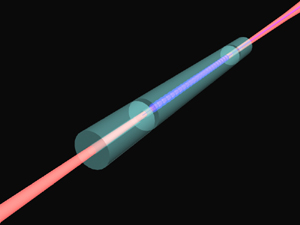






 |
 |

Schematic of the Waveguide
Caption:
This picture shows a schematic of the waveguide, the modulated hollow-core fiber used to efficiently generate shorter wavelength EUV light. The wall of the hollow fiber is modulated - wavelike, with indentations 10-micrometers (µm) deep, periodically spaced every 0.5 mm (in the highest-intensity waveguide). The average inner diameter of the fiber is 150µm. By modulating the diameter of the fiber, the researchers modulate the intensity of the initial laser beam, and therefore also modulate the process that produces the EUV light. The researchers adjusted the period of the wavelike modulations to restrict the EUV emission to regions where the light waves will be in phase - this is how the researchers were able to generate shorter wavelength light more efficiently than was previously possible. [See related images: Research Associates with Laser System, Waveguide, Close-Up of Waveguide, Femtosecond Laser Amplifier System.]
More about this Image
A National Science Foundation (NSF) supported research team from the University of Colorado’s Joint Institute for Laboratory Astrophysics (JILA), have created an extreme-ultraviolet, laser-like beam capable of producing tightly-focused light in a region of the electromagnetic spectrum not previously accessible to scientists. The process combines concepts from electromagnetic radiation research and fiber optics.
The extreme-ultraviolet (EUV) wavelengths, which are between 1 and 100 times shorter than visible light waves, will allow researchers to “see” tiny features and carve miniature patterns with applications in such fields as microscopy, lithography, and nanotechnology.
The achievement is based on a new structure called a “waveguide,” a hollow glass tube with internal humps that coax light waves into traveling along at the same speed and help the waves reinforce each other.
These findings were reported in the January 2 issue of the journal Nature. The research was principally supported by NSF, with additional funds from the Department of Energy. For further information about the research, see NSF Press Release 03-01.

(Preview Only)

|
| Credit: |
Image courtesy of the University of Colorado and NSF. |
| Year of Image: |
2002 |
|
Categories:
PHYSICS / General
Formats Available:
Restrictions:
No additional restrictions--beyond NSF's general restrictions--have been placed on this image. For a list of general restrictions that apply to this and all images in the NSF Image Library, see the section "Conditions".
|